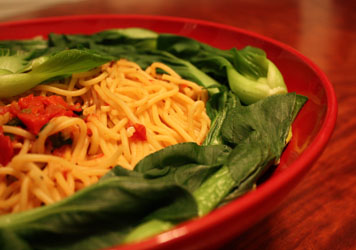Wanting 'one right way' - resisting multiculturalism, diversity, tolerance

What started as pasta aioli, now with baby bok choi, red bell peppers, cilantro, and shoyu. Photo courtesy of my daughter Margot
I was surprised because my family is northern Chinese and so I have been eating and making noodles all my life. I was speechless when he pushed me aside in my own kitchen and instructed me on How To Make Noodles—by peeling and mincing the garlic just so and drizzling the noodles with olive oil. Years later, I learned that this recipe is called pasta aioli, and is certainly one way of making noodles, but in his mind, it was the only way to make noodles, and I was wrong for wanting to make them any other way. (He thought I was wrong for crushing the garlic with my grandmother’s cleaver, too.)
Soon thereafter, I was at an Italian couple’s home with a group of friends when dinnertime overtook us. Our hosts started making pasta with a simple marinara sauce to feed everybody. All the women gathered around the kitchen, ooohing and ahhhing and watching and learning until someone commented, “You’re such a good cook.” Cici with her long white hair and throaty accent was completely unimpressed, “I am not a good cook, I am just Italian.”
So, a week after Thanksgiving, I am still mulling over the hostility and defensiveness I encountered when I described the different foods from around the world my family enjoys at Thanksgiving. I thought it was so innocent. What difference does it make to other people eating Thanksgiving dinner in their house what I eat in my house? Why is choosing sticky rice stuffing rather than dry bread stuffing so threatening? People from the South make stuffing with cornbread, people from the Northeast make it with oysters, and people from Minnesota make it with wild rice. The beauty is there is no one “right way” to do Thanksgiving…or to be American. There is room for everyone at this table.
This is not just about immigrant families and families of color, I know lots of married couples who come from families who celebrate holidays differently and have to compromise. Do they stop celebrating Thanksgiving because one spouse likes marshmallows on top of the sweet potatoes and the other prefers them glazed in maple syrup? Do they give up on Christmas because one spouse likes to open presents Christmas Eve and the other opens presents Christmas morning? Is the rub of multiculturalism/diversity/tolerance like having to adapt to the weird and annoying habits of your spouse and his/her family? Why can’t everything just be “normal” (like me)?!!
Anyhow, there is no evidence that turkey was even eaten at the first Thanksgiving. The Pilgrims and Wampanoags likely ate venison and lobster (mostly provided by the Wampanoags, who today lead a sobering National Day of Mourning). They certainly did not eat green bean casserole with Cambell’s Soup or sweet potatoes with marshmallows. One story behind the turkey is that the Queen of England happened to be eating roast goose when she was informed that the English Navy had defeated the Spanish Armada in 1588, and so she called for a second goose to celebrate and then decreed that everyone eat goose at Christmas—so goose became the meat of choice for English family celebrations. However, in America, wild turkey was easier to find than goose. So our beloved Thanksgiving turkey is a specifically English custom, brought over by immigrants, and then adapted, to make it ours.
Frances Kai-Hwa Wang is a second-generation Chinese American from California who now divides her time between Ann Arbor and the Big Island of Hawaii. She is editor of IMDiversity.com Asian American Village, lead multicultural contributor for AnnArbor.com, and a contributor for New America Media's Ethnoblog. She is a popular speaker on Asian Pacific American and multicultural issues. Check out her website at franceskaihwawang.com, her blog at franceskaihwawang.blogspot.com, and she can be reached at fkwang888@gmail.com.


Comments
Frances Kai-Hwa Wang
Fri, Dec 25, 2009 : 8:12 a.m.
Thanks everyone for your thoughtful comments, emails, and facebook discussions. Although I know there were only two negative comments in the original article, that is usually indicative of many more who hold those views but are not voicing them. The great response has been refreshing, and the conversation has been really interesting.
Jessica Webster
Mon, Dec 7, 2009 : 9:56 a.m.
Very thoughtful piece, Frances. I have really been enjoying your posts.
foreigner
Sun, Dec 6, 2009 : 11:50 a.m.
Excellent article! Food and music are two things that often help bring different cultures together.
silo
Sun, Dec 6, 2009 : 10:17 a.m.
Thank you for this article! Empathy and understanding are two abilities to be truly thankful for. :)
Janice
Sun, Dec 6, 2009 : 9:48 a.m.
The narrow mindedness of some people is truly amazing. However, as far as I saw, there were only two ridiculous comments of this sort, and the extremists are always the ones to speak out. I think the vast majority of people in this town do not share their views. I'd love a little variety in my Thanksgiving meal!